|
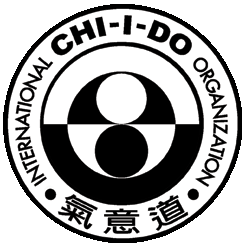
 Bo - Ruku - Bo means staff - ruku mean six foot - it is a six foot staff used by farmers to carry their harvest goods or other items. They would carry the items at the ends with the middle of the Bo balanced on their shoulders or back. The boat workers or sailors used to maneuver their vessels with these staffs. Their staffs were longer, such as 7 to 8 foot. There are many various ways of using the Bo with the different blocks, strikes and patterns. The Bo should be learnt by everyone to understand how weapons move and the characteristics of weapons. ...top Bo - Ruku - Bo means staff - ruku mean six foot - it is a six foot staff used by farmers to carry their harvest goods or other items. They would carry the items at the ends with the middle of the Bo balanced on their shoulders or back. The boat workers or sailors used to maneuver their vessels with these staffs. Their staffs were longer, such as 7 to 8 foot. There are many various ways of using the Bo with the different blocks, strikes and patterns. The Bo should be learnt by everyone to understand how weapons move and the characteristics of weapons. ...top
|
 Eku or Kai - it is a boat oar or paddle used by the boat workers or sailors. The movements are almost like those of the Bo, coupled with the paddle side which is used to scoop sand or for scooping blocks or as a cutter by the edge side. The Kata when done right looks as if the pattern is of one rowing on the water, and it then changes to fighting scene -- a Yin and Yang effect -- the art of the Eku. ...top Eku or Kai - it is a boat oar or paddle used by the boat workers or sailors. The movements are almost like those of the Bo, coupled with the paddle side which is used to scoop sand or for scooping blocks or as a cutter by the edge side. The Kata when done right looks as if the pattern is of one rowing on the water, and it then changes to fighting scene -- a Yin and Yang effect -- the art of the Eku. ...top
|
 Nunti-Bo is an instrument used for guarding a castle, domain or a gateway. It has a Nunti attached to a Bo at the height of one eyebrows. The movements are like those of the Bo with the movements of Nunti at an extension. There are many spear like attacking movements and whirling spinning blocks. There are also a lot of other movements which are not found in any other weapons which makes this weapons very superior and, as an art, beautiful in its movements. ...top Nunti-Bo is an instrument used for guarding a castle, domain or a gateway. It has a Nunti attached to a Bo at the height of one eyebrows. The movements are like those of the Bo with the movements of Nunti at an extension. There are many spear like attacking movements and whirling spinning blocks. There are also a lot of other movements which are not found in any other weapons which makes this weapons very superior and, as an art, beautiful in its movements. ...top |
| Naginata - Coming Soon |
 Nunti - Its origins are said to have evolved from a Buddhist religious hand held talisman instrument. Its design was later changed to be used as a weapon. It is a favorite from the Southeastern China section and many of the schools in this area favor the Nunti. The Nunti is said to represent the hands in all capacities. What ever the hand does, the Nunti can do. It is famous for the ability to grab other weapons with the prongs. Its prongs can hook and grab "inwards" or the "outwards" just like hands and it can stop an oncoming weapon. It can block in many or various ways just like the "hand" or the "arm." Its striking patterns also represents the various ways just like the hand. It can point, jab, spear, thrust and etc. The two long ends can poke and stab a mean hole rendering the opponent helpless in pain or break joints and damage bones. It works as an instrument to "strike-poke" the points of the body known as "jutte" or as "dim mak" or "tui-i-te" creating pain or paralysis. It takes a "different" type of person with a complete mental psychic to make this weapon to become with one as a whole. Accuracy and a mind of Zen mushin (zero state) is a necessity. It is said that anyone who has mastered the Nunti, then they have mastery and have a complete control of "oneself" and the art of "Te" art as well. This is the one of the principle of Buddhism -- control and understand of oneself. This short weapon is the highest caliper in the training and usage of Kobudo. These weapons are used in pairs and they can be thrown to pin the opponents with devastating piercing power and accuracy. ...top Nunti - Its origins are said to have evolved from a Buddhist religious hand held talisman instrument. Its design was later changed to be used as a weapon. It is a favorite from the Southeastern China section and many of the schools in this area favor the Nunti. The Nunti is said to represent the hands in all capacities. What ever the hand does, the Nunti can do. It is famous for the ability to grab other weapons with the prongs. Its prongs can hook and grab "inwards" or the "outwards" just like hands and it can stop an oncoming weapon. It can block in many or various ways just like the "hand" or the "arm." Its striking patterns also represents the various ways just like the hand. It can point, jab, spear, thrust and etc. The two long ends can poke and stab a mean hole rendering the opponent helpless in pain or break joints and damage bones. It works as an instrument to "strike-poke" the points of the body known as "jutte" or as "dim mak" or "tui-i-te" creating pain or paralysis. It takes a "different" type of person with a complete mental psychic to make this weapon to become with one as a whole. Accuracy and a mind of Zen mushin (zero state) is a necessity. It is said that anyone who has mastered the Nunti, then they have mastery and have a complete control of "oneself" and the art of "Te" art as well. This is the one of the principle of Buddhism -- control and understand of oneself. This short weapon is the highest caliper in the training and usage of Kobudo. These weapons are used in pairs and they can be thrown to pin the opponents with devastating piercing power and accuracy. ...top
|
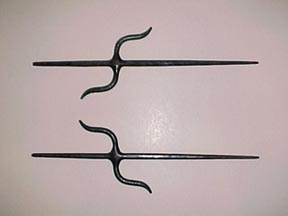 Manjin Sai - is a modified from the Nunti. Majority of the movements and principles are the same. Since one of the shaft end is shorter, the manipulation is slightly different from the Nunti. It only has one side to manipulate, because of this, which makes this weapon a faster striking weapon with its longer shaft then the Nunti. It has a lot of parrying defense movements with lots of whacking type of striking attacking movements and it can also be thrown. ...top Manjin Sai - is a modified from the Nunti. Majority of the movements and principles are the same. Since one of the shaft end is shorter, the manipulation is slightly different from the Nunti. It only has one side to manipulate, because of this, which makes this weapon a faster striking weapon with its longer shaft then the Nunti. It has a lot of parrying defense movements with lots of whacking type of striking attacking movements and it can also be thrown. ...top
|
 Sai - the Sai is the Manji Sai with modifications to the prongs hooks. Both prongs hooks are facing in the same direction facing forward towards the long shaft while the short end is handle. It was said that the prongs was set this way for many of the martial artist who used the Manji Sai and Nunti have lost heir thumbs due to their inability to keep their composure in combat. Its usage is almost similar to their predecessors and can also be thrown. This is the contemporary Sai that all the martial artist uses in the Kobudo training up to today. ...top Sai - the Sai is the Manji Sai with modifications to the prongs hooks. Both prongs hooks are facing in the same direction facing forward towards the long shaft while the short end is handle. It was said that the prongs was set this way for many of the martial artist who used the Manji Sai and Nunti have lost heir thumbs due to their inability to keep their composure in combat. Its usage is almost similar to their predecessors and can also be thrown. This is the contemporary Sai that all the martial artist uses in the Kobudo training up to today. ...top |
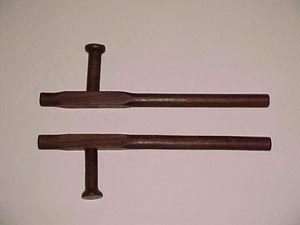 Tuifa or Tonfa is household and agriculture implement. As a household tool, it is used as a handle for a grinding wheel -- a millet for corn, rice, grain and etc. The long end would fit into the side of the wheel, while you would turn the millet wheel by the handle end. As an agricultural tool it is also used with spade - the short end to scoop out yams in the ground. They would hold it by the handle and "punch" the spade into ground and then scoop up the yam. The articulation as a weapon is spinning by the handle. This spinning creates motion and power for blocking, punching, striking and etc. The tuifa are fast and powerful in their own rights. They are used in pairs. ...top Tuifa or Tonfa is household and agriculture implement. As a household tool, it is used as a handle for a grinding wheel -- a millet for corn, rice, grain and etc. The long end would fit into the side of the wheel, while you would turn the millet wheel by the handle end. As an agricultural tool it is also used with spade - the short end to scoop out yams in the ground. They would hold it by the handle and "punch" the spade into ground and then scoop up the yam. The articulation as a weapon is spinning by the handle. This spinning creates motion and power for blocking, punching, striking and etc. The tuifa are fast and powerful in their own rights. They are used in pairs. ...top |
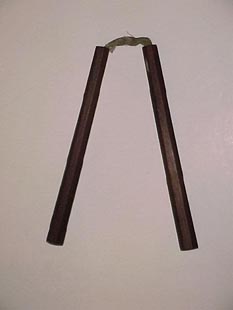 Nunchaku -- Originally, nunchaku was a horse's bridal. Each of its lengths was as long as the horse's head which is twenty plus inches long with a short piece for the horse's month. This middle piece is about five to six inches in length. The three pieces were looped at the ends with rope made of hair in the past and nylon at the present. The length of the three pieces was about four feet. When the horseman was attacked, he would pull the Nunchaku-bridal off the horse's head and with big swings batter with crushing blows, overpowering the enemy. If the user knows how to use the Nunchaku, it should or would puncture a hole in his opponent. It is not to be used like many people in the movies the way Bruce Lee did. Bruce Lee made it looks nice - convincing and scary, but it is still wrong. This is the reason why many people who use the nunchaku complain about the striking end bouncing off and hitting themselves on the "holding hand." Eventually because of the power of the nunchaku, the length was shortened to be about twelve to fifteen inches in length, for the convenience of being carried around as a weapon. The practice of the Nunchaku has various swinging patterns in many different directions, over head and under hand swings and etc. It has a few blocks, so few, almost consider as none. ...top Nunchaku -- Originally, nunchaku was a horse's bridal. Each of its lengths was as long as the horse's head which is twenty plus inches long with a short piece for the horse's month. This middle piece is about five to six inches in length. The three pieces were looped at the ends with rope made of hair in the past and nylon at the present. The length of the three pieces was about four feet. When the horseman was attacked, he would pull the Nunchaku-bridal off the horse's head and with big swings batter with crushing blows, overpowering the enemy. If the user knows how to use the Nunchaku, it should or would puncture a hole in his opponent. It is not to be used like many people in the movies the way Bruce Lee did. Bruce Lee made it looks nice - convincing and scary, but it is still wrong. This is the reason why many people who use the nunchaku complain about the striking end bouncing off and hitting themselves on the "holding hand." Eventually because of the power of the nunchaku, the length was shortened to be about twelve to fifteen inches in length, for the convenience of being carried around as a weapon. The practice of the Nunchaku has various swinging patterns in many different directions, over head and under hand swings and etc. It has a few blocks, so few, almost consider as none. ...top |
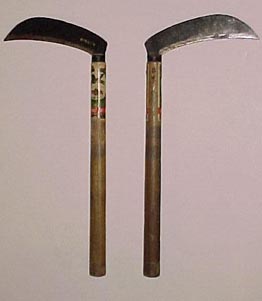 Kama is an agriculture utensil. It is used as cutting instrument for harvesting sugar cane, wheat, rice, grain and etc. Articulation includes various spinning and hook strikes and blocks with the blade, back of the blade and the handle. The kamas can be used in pairs or single. They can be chained or roped together as pairs or with a ball or spiked end and swung around to capture or to attack the opponets limbs or body. They are extremely sharp. Decapitation was not uncommon. Matayoshi's family is famous for the Kamas and Master Shinpo Matayoshi used to practice "blind folded." This method of practice was enforced by Grand Master Shinko Matayoshi the father. On the island of Okinawa, the Matayoshi's Kamas are second to none -- they are number one. ...top Kama is an agriculture utensil. It is used as cutting instrument for harvesting sugar cane, wheat, rice, grain and etc. Articulation includes various spinning and hook strikes and blocks with the blade, back of the blade and the handle. The kamas can be used in pairs or single. They can be chained or roped together as pairs or with a ball or spiked end and swung around to capture or to attack the opponets limbs or body. They are extremely sharp. Decapitation was not uncommon. Matayoshi's family is famous for the Kamas and Master Shinpo Matayoshi used to practice "blind folded." This method of practice was enforced by Grand Master Shinko Matayoshi the father. On the island of Okinawa, the Matayoshi's Kamas are second to none -- they are number one. ...top
|
|
|
|

